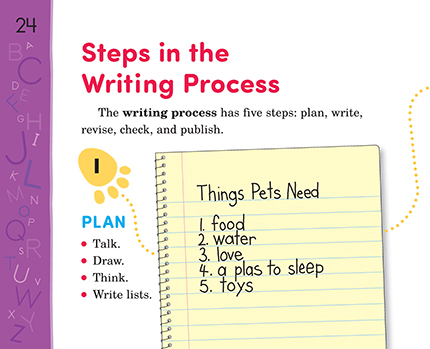Lesson Plan
- Read and discuss Krista’s report, “Things Pets Need,” on page 27. Comment on the neat handwriting and spacing of words. Explain that Krista did a lot of important things before she made this final copy, using the writing process to complete her report. Her writing had to go through a series of steps before it was ready to share.
- Then explain the writing process by telling the following story about Krista.
Planning
- Krista was six years old, and all her life she had wanted a pet! One day her mom told her she could get a pet if she would learn to take care of it. So Krista made a list of the things pets need. (Read the list on page 24.)
Writing
- Krista brought the list to school to show her teacher. Her teacher said she would help Krista make her list into a report. So Krista wrote some sentences about the things on her list. (Read the draft on page 25.)
Revising and Checking
- Later in the day, the teacher helped Krista with her report. First she asked Krista to read her report aloud. Then they talked about ways to make the writing better, adding a new word (fresh) and changing others (toys to fun). Krista’s teacher also helped her check for correct capital letters, punctuation, and spelling. (Look at the revised and checked draft on page 26.)
Publishing
- The next day Krista wrote her final draft. It was the very best she could do! She took it home and gave it to her mom. (Look at page 27.) Do you think she got her pet?
Using the Writing Process
- Have regular conversations about the writing process with children, using pages 24-27 as your guide. Be sure to remind students that some of their writing can remain at a first-draft stage. Use "Steps in the Writing Process," to help students review the whole process.
- Support students during the revising phase by providing them "I Check My Writing," which reminds them of the sorts of things they should look for. You can also help students respond to each others' writing using "Peer Conference."
Note: Planning writing may be one of the most comfortable parts of the process for some young learners. Gathering ideas, thinking them through, and talking about them may be the students’ primary mode of communication for now. Don’t underestimate the importance of these activities for developing writers. Learners who are not yet able to write a first draft may dictate their ideas to a “scribe” (teacher or other adult) or simply talk about them in an oral report.
Some Notes About Conferencing
- One of the most important things you can do for emerging writers is to conference with them as often as possible. Conferencing can be done informally as you walk around the classroom or more formally during a scheduled meeting. What is most important is that you listen and respond to each child on a regular basis.
- A classroom environment where children are accustomed to working independently or in small groups for a period of time will give you the freedom to hold conferences while the other children are productively involved.
- Most conferences with beginning writers should probably be “listening sessions” that end with specific direction in one area and plenty of encouraging words.
Reflecting on Writing
After students complete their writing, you can help them lock in what they have learned by reflecting on the experience. Use "Thinking About Writing" whenever students have finished a writing assignment.

